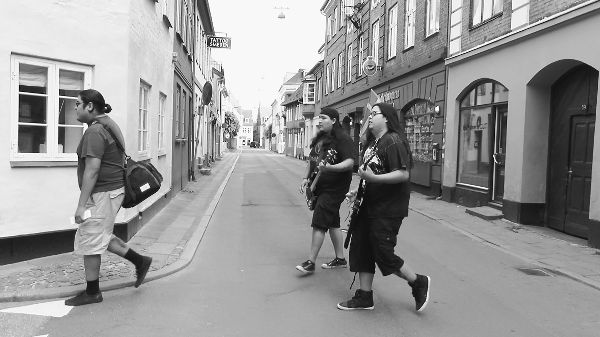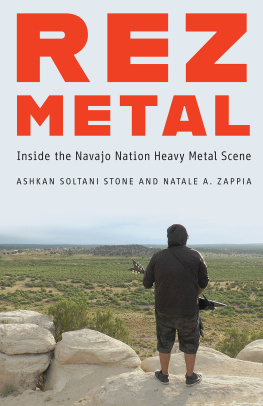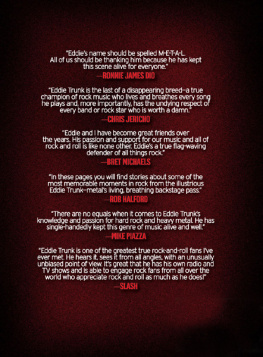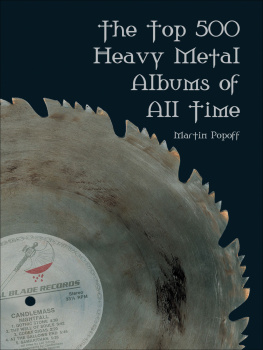
Rez Metal represents the creative genius of contemporary Indigenous popular culture. Set within the heart of the Navajo Nation and including the voices of elders, council members, and metalheads of all ages, Soltani Stone and Zappia demonstrate the importance of metal as a source of hope and inspiration for Indigenous youth and its prominence as an organic Indigenous expressive culture.
Kyle T. Mays, author of Hip Hop Beats, Indigenous Rhymes: Modernity and Hip Hop in Indigenous North America

Rez Metal
Inside the Navajo Nation Heavy Metal Scene
Ashkan Soltani Stone and Natale A. Zappia
University of Nebraska Press | Lincoln
2020 by the Board of Regents of the University of Nebraska
Cover designed by University of Nebraska Press; cover image: Kyle Felter with guitar.
All photos by Ashkan Soltani Stone.
All rights reserved.
Library of Congress Cataloging-in-Publication Data
Names: Soltani Stone, Ashkan, author. | Zappia, Natale A., author.
Title: Rez metal: inside the Navajo Nation heavy metal scene / Ashkan Soltani Stone and Natale A. Zappia.
Description: Lincoln: University of Nebraska Press, 2020. | This book consists primarily of the voices, lyrics, and images emerging from Navajo communities and rez metal culture, and is a companion to the documentary film Rez metal. | Includes bibliographical references.
Identifiers: LCCN 2019044532
ISBN 9781496205094 (paperback)
ISBN 9781496222480 (epub)
ISBN 9781496222497 (mobi)
ISBN 9781496222503 (pdf)
Subjects: LCSH : Navajo IndiansMusic. | Heavy metal (Music)Navajo Nation, Arizona, New Mexico & Utah.
Classification: LCC E 99. N 3 S 655 2020 | DDC 781.66089/9726dc23
LC record available at https://lccn.loc.gov/2019044532
The publisher does not have any control over and does not assume any responsibility for author or third-party websites or their content.
Contents
This book rests upon the energy, passion, and creativity of all of the Indigenous musicians featured in the following pages. We are both deeply grateful for the opportunities to meet these people and document this remarkable music scene. We would like to thank the Office of the President and Vice President on the Navajo Nation, Mechelle Morgan Flowers, Craig Matarrese, Veronica Quam (Laydi Rayne), City of Window Rock, City of Gallup, Sweet Silence Studio, SER Studio, Liza Black, Raedean Silversmith-Yazzie, Tito Hoover, Navajo Metal Promotions, Kimberly Berchman, Sammy Chioda, Christopher S. Pineo, Chuck Billy, and the band Testament.
We would like to dedicate this book in loving memory of Edwin Yazzi, Shauna Lee, Reese Tsosie, and other members of the Rez Metal family whom we met and tragically lost during the making of the documentary and this book.
We also thank our editor Matt Bokovoy from the University of Nebraska Press ( UNP ) for his vision, enthusiasm, and excellent feedback during the process. Thanks as well to Heather Stauffer at UNP and to the anonymous reviewers who helped make this a better book. All the proceeds from Rez Metal will go the Native American Music Fund, located in Window Rock, Arizona.
History of the Project and Arrangement of the Book
This book consists primarily of the voices, lyrics, and images emerging from Navajo communities and rez metal culture. It is part of a larger film project documenting the scene and serves as a companion to the documentary Rez Metal. The film, directed and produced by co-author Ashkan Soltani Stone, provides an intimate portrait of the kaleidoscope of musical performances, concerts, and interviews involving its participants. Among the primary filming locations are Window Rock, Thoreau, Ship Rock, and Red Valley on the Navajo Reservation as well as Gallup and Farmington, New Mexico. Soltani further explores different types of venues including the areas central metal venue, Juggernaut music in Gallup, as well as unconventional makeshift spaces on family plots and housing projects. He also films several reservation-based record producers and other Navajo-directed endeavors, including youth heavy metal workshops, teaching programs (sponsored by the Native American Music Fund), and tribal governmentsponsored initiatives supporting mentoring for the next generation of rez metal musicians. The film features diverse groups of musicians: from an all-female Navajo metal band to a rez band on the verge of breaking into the mainstream. Most recently Flemming Rasmussen agreed to produce the debut album of I Dont Konform, one of the central bands featured in the film. Mr. Rasmussen has actively participated in the documentary, playing a role as an important character while also hosting I Dont Konform at his Sweet Silence Studios in Denmark. Many of these characters and venues also play a central role in this book.
Rez Metal is divided into four sections that include a montage of images and featured interviews. Our first series of interviews follows this introduction in chapter 1, What Is Rez Metal? Our interviewees trace its origins on the Navajo Reservation, where it has been the most vibrant and diffuse, discussing the benefits of rez metal but also some of the controversies it has engendered. Among interviews transcribed in this chapter are conversations with Jonathan Nez, who was the tribal president at the time of writing (vice president at the time of the interview), medicine woman Lavina Pete, and Jerold Cecil, manager of I Dont Konform.

I Dont Konform in Copenhagen
Chapter 2, Venues, focuses on three primary performance spaces for rez metal: Gallup, house parties, and rez slaughter tours. We begin at the rez metal mecca of Gallup, New Mexico. Gallup is known as the capital of Indian Country. With its proximity to several reservations and its service as a destination for major powwows, rodeos, and other cultural events, Gallup proudly celebrates its Native and western heritage. However, darker, more foreboding sides of the city also lurk alongside these events. High unemployment, drug addiction, and a growing homeless population shape the cultural contours of this urban space. Rez metal taps into these tensions, making Gallup a go to site for touring bands and hosting a thriving music scene.
The overwhelming majority of fans hail from the Navajo, Zuni, and Hopi Reservations. This chapter explores these unique dimensions through a series of interviews with Ernie Santiago and Brandon Tsosie, owners of the clubs Juggernaut and Studio 18. The section on house parties highlights the incredibly rich and dynamic nature of rez metal. It is at the impromptu jam sessions held at house parties across the reservation that the remarkable sounds emerge. These moments are captured in this chapter through interviews with local bands and fans participating in this shared experience. These gatherings, at times spontaneous, have given rise to more formal, reservation-wide concerts, and description of the reservation slaughter tour documents this phenomenon through interviews with traveling bands and fans who all share their deep connections with heavy metal.
Chapter 3, The Band, closely follows the story of I Dont Konform. This fascinating profile incorporates all of the aspects of the rez metal scene through the journey of the band from the Navajo Reservation all the way to Copenhagen. In the interviews, lead singer Kyle Felter remarks how the band members see themselves as ambassadors of a nation. This sentiment reflects the transcendent nature of this underground music scene and its ability to make global connections. Other interviewees include Flemming Rasmussen and his recollection of a remarkable trip to meet the band and the Navajo Nations president and vice president.
Next page











